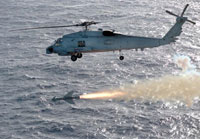
|
||
|
PENGUIN |
||||||||||||||||||||
|
The Penguin anti-ship missile made by Kongsberg Defence & Aerospace (KDA) of Norway from the early 1970s and continually upgraded since, is a passive-IR seeker based short-to-medium range naval cruise missile. It is designated the AGM-119 in US service.
It was the first Anti-ship missile of the western world with an IR seeker (as opposed to the more commonly used active radar technology).The Penguin can be fired singly or in coordinated-arrival salvoes.
Propelled
by a solid rocket engine, it performs random weaving manoeuvres at
target approach and hits the target close to the waterline. Of the
western inventory of such missiles, it is the only variant that
performs a terminal bunt and weave manoeuvre. The modified 120 kg
Bullpup warhead detonates inside the target (ship) by using a delay
fuse.
KDA's
successor to the Penguin will be the Naval Strike Missile (NSM). NSM will feature an imaging
IR-seeker, GPS navigation, a turbojet sustainer engine (for much
longer ranges: 150+km), and significantly more computer performance
and digital signal processing power.
|
||||||||||||||||||||
